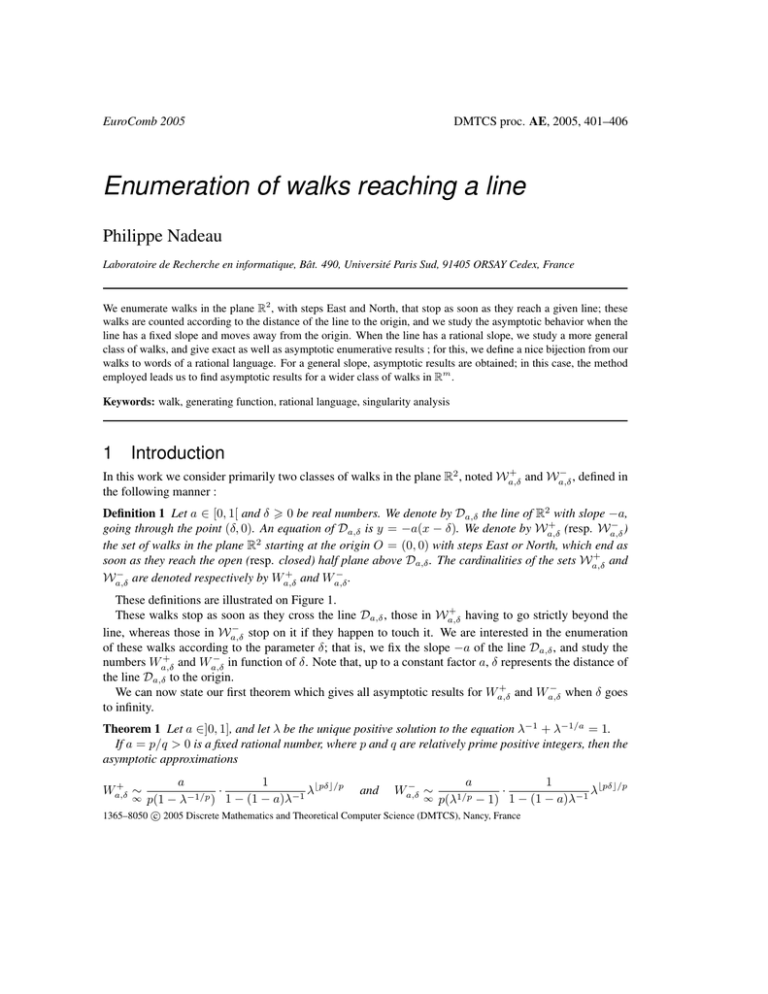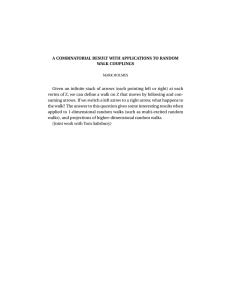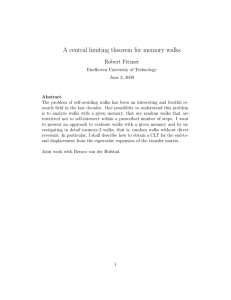Enumeration of walks reaching a line Philippe Nadeau EuroComb 2005
advertisement

DMTCS proc. AE, 2005, 401–406
EuroComb 2005
Enumeration of walks reaching a line
Philippe Nadeau
Laboratoire de Recherche en informatique, Bât. 490, Université Paris Sud, 91405 ORSAY Cedex, France
We enumerate walks in the plane R2 , with steps East and North, that stop as soon as they reach a given line; these
walks are counted according to the distance of the line to the origin, and we study the asymptotic behavior when the
line has a fixed slope and moves away from the origin. When the line has a rational slope, we study a more general
class of walks, and give exact as well as asymptotic enumerative results ; for this, we define a nice bijection from our
walks to words of a rational language. For a general slope, asymptotic results are obtained; in this case, the method
employed leads us to find asymptotic results for a wider class of walks in Rm .
Keywords: walk, generating function, rational language, singularity analysis
1
Introduction
+
−
In this work we consider primarily two classes of walks in the plane R2 , noted Wa,δ
and Wa,δ
, defined in
the following manner :
Definition 1 Let a ∈ [0, 1[ and δ > 0 be real numbers. We denote by Da,δ the line of R2 with slope −a,
+
−
going through the point (δ, 0). An equation of Da,δ is y = −a(x − δ). We denote by Wa,δ
(resp. Wa,δ
)
2
the set of walks in the plane R starting at the origin O = (0, 0) with steps East or North, which end as
+
soon as they reach the open (resp. closed) half plane above Da,δ . The cardinalities of the sets Wa,δ
and
−
+
−
Wa,δ are denoted respectively by Wa,δ and Wa,δ .
These definitions are illustrated on Figure 1.
+
These walks stop as soon as they cross the line Da,δ , those in Wa,δ
having to go strictly beyond the
−
line, whereas those in Wa,δ stop on it if they happen to touch it. We are interested in the enumeration
of these walks according to the parameter δ; that is, we fix the slope −a of the line Da,δ , and study the
+
−
numbers Wa,δ
and Wa,δ
in function of δ. Note that, up to a constant factor a, δ represents the distance of
the line Da,δ to the origin.
+
−
We can now state our first theorem which gives all asymptotic results for Wa,δ
and Wa,δ
when δ goes
to infinity.
Theorem 1 Let a ∈]0, 1], and let λ be the unique positive solution to the equation λ−1 + λ−1/a = 1.
If a = p/q > 0 is a fixed rational number, where p and q are relatively prime positive integers, then the
asymptotic approximations
+
Wa,δ
∼
∞
a
1
·
λbpδc/p
−1/p
p(1 − λ
) 1 − (1 − a)λ−1
and
−
Wa,δ
∼
∞
a
p(λ1/p
1
λbpδc/p
− 1) 1 − (1 − a)λ−1
·
c 2005 Discrete Mathematics and Theoretical Computer Science (DMTCS), Nancy, France
1365–8050 402
Philippe Nadeau
111
000
111
000
000 000
111
000 111
111
111
000
111
000
111
000 000
111
000
111
000
111
111
000
000
000
111
000 111
111
111
000
000
111
111
000
000
111
000
111
000 111
111
111 000
000
000
111
000
111
111
000
000
111
111
000
000
111 111
000
000 111
000
000 111
111
111
000
111
000
000
111
111
000
000
000 111
111
000
000 111
111
111
000
000
111
000
111
000
111
000
111
O
+
Fig. 1: An example of walk in Wa,δ
with a =
3
7
and n = 14.
hold when δ goes to infinity. If a is irrational, then the asymptotic approximations
+
Wa,δ
∼
∞
1
a
·
λδ
ln λ 1 − (1 − a)λ−1
and
−
Wa,δ
∼
∞
a
1
·
λδ
ln λ 1 − (1 − a)λ−1
hold when δ goes to infinity.
+
−
As this theorem shows, the behavior of Wa,δ
and Wa,δ
depends on the rationality of the number a; if
−
+
. In this case, we
and Wa,n
a is rational, then we will find the generating function of the numbers Wa,n
−
+
will actually introduce another class of walks that includes Wa,n and Wa,n and find a bijection that sends
walks to words of a rational language; various enumerative and asymptotic results derive from there. In
the case of a general a, we will proceed differently, and start from an easily obtained functional equation
to obtain asymptotic results. Our method is close to Erdös et al. (EHO+ 87), method that is also applicable
to a wider class of walks defined in Rn .
2
Walks reaching a set of points
As announced in the introduction, we now introduce a new class of walks that will include our original
walks when the slope of Da,δ is rational. The reader is advised to look at Figure 2 while reading the
following definition.
Definition 2 (Vd,n and Wd,n ) Let d = (di )i>1 be an infinite sequence of positive integers, and let e =
(ei )i∈N be the corresponding sequence of partial sums, defined by e0 = 0 and ek = d1 + d2 + · · · + dk ,
for k > 1. We associate to d a set of points Vd in the plane, with integer coordinates: the set Vd ⊂ Z × N
consists in the origin O together with, for every k > 1, the dk points with y-coordinate equal to k and
x-coordinate in [[−ek , −ek−1 − 1]].
For any integer n, Vd,n is defined as the translated of Vd by the vector (n, 0). That is, Vd,n = Vd +(n, 0).
The generalized set of walks Wd,n consists of the walks that start at the origin O, make steps East or
North, and have their last points, and no other one, in Vd,n .
+
−
−
These walks are a generalization of our walks Wa,n
and Wa,n
. Indeed, let d+
a and da be the sequences
k
k−1
k
k−1
whose kth terms are given respectively by d a e − d a e and b a c − b a c. Then we have the following
proposition :
403
Walks reaching a line
11
00
00 11001100 1100
11
1100 1100
1100 1100 1100 11
00 1100 1100 1100
1100 1100 11
00 1100 1100 1100 1100 1100 1100
1100 1100 1100 1100 11
00
1100 11
00 1100
1100 1100 1100 1100
1100 1100 1100 1100
1100
Fig. 2: A set Vd,n with examples of walks in Wd,n . Here n = 14 and d = (3, 1, 2, 3, 6, 1, 1, . . .)
Proposition 1 For every n ∈ N and a ∈]0, 1], we have the equalities
−
+
.
and Wa,n
= Wd−
Wa,n
= Wd+
a ,n
a ,n+1
−
An interesting case happens when the sequence d is periodic. It is easy to see that d+
a and da are
periodic exactly when a is a rational number. If d = (d1 , . . . , dp ) is a finite sequence, we will note
Vd,n = Vd,n
¯ and Wd,n = Wd,n
¯ , where d¯ is the periodic infinite sequence (d1 , . . . , dp , d1 , . . . , dp , . . .).
From now on d will stand for a finite sequence d = (d1 , . . . , dp ) of positive integers. We define
q = d1 + · · · dp , and a = p/q. To such a sequence we attach the following language on a finite alphabet
(recall that a run in a finite word is a maximal factor composed of identical letters)
Definition 3 (Language Ld ) The language Ld is the set of words w on the alphabet Σ = {a0 , a1 , . . . , ap−1 }
that satisfy the following conditions (where we set by convention d0 = dp and ap = a0 ):
C1. w is the empty word, or its initial letter belongs to {a0 , a1 }
C2. for all i, a run of ai in w is terminal or is followed by a run of ai+1 ;
C3. for all i, the runs of ai in w are of length at least di ; this constraint does not apply to the last run,
and, if w begins with a0 , it does not apply to the first run either.
We can finally state the theorem announced in the introduction:
Theorem 2 Let n > 0 be an integer. There exists an explicit bijection between walks in Wd,n and words
of Ld of length n.
The language Ld is rational, and we give an unambiguous rational expression that represents it. Then
the
P∞existence kof a bijection as stated in Theorem 2 allows us to explicit the generating function Wd (x) =
k=0 Wd,k x of the sequence (Wd,n )n∈N :
Theorem 3 The generating function Wd (x) has the following expression:
Wd (x) =
p−2
X
N (x)
p−2
,
with
N
(x)
=
(1
−
x)
+
xei +1 (1 − x)p−2−i +
(1 − x)p − xq
i=1
ep −1
X
k=ep−1 +1
xk .
404
Philippe Nadeau
Given a rational function, we can easily have access to asymptotic approximations of the coefficients of
its series expansion, and we show that the first part of Theorem 1 can thus be obtained as a consequence
of Theorem 3.
In fact, thanks to the bijection of Theorem 2, we can even find the bivariate generating function of
the numbers (Wd,n,k )n,k which enumerate walks in Wd,n of length k. By the techniques of singularity
analysis exposed in chapter 8 of (FS), we can then prove that the average length of a walk in Wd,n is
asymptotically Ca · n when n goes to infinity, where Ca is positive constant depending only on a.
3
Asymptotic results in the general case
+
Let Wa+ be the function defined on R by Wa+ (δ) = 1 if δ < 0, and by Wa+ (δ) = Wa,δ
if δ > 0. Then,
+
by decomposing walks according to their first step, one shows that Wa satisfies the following functional
equation :
∀δ > 0,
Wa+ (δ) = Wa+ (δ − 1/a) + Wa+ (δ − 1).
(1)
This equation and related ones have appeared in various contexts, and have been studied in numerous
works, including (CG01; FK74; Pip93). Here we use a method inspired by the paper (EHO+ 87). This
consists in interpreting Equation 1 as a “renewal equation”, so that its asymptotic behavior is given by the
celebrated Renewal Limit Theorem (RLT) of probability theory; see Feller (Fel71) for all necessary back+
ground. Application of the RLT immediately leads to a proof of Theorem 1 as far as Wa,δ
is concerned.
−
It is then extended to Wa,δ by finding simple relations between the two numbers.
Our walks have a natural generalization in any dimension. Let ā = (a1 , . . . , am ) be a vector in
Rm , with all coordinates being positive, and Hδ be the hyperplane of equation Hδ : a1 x1 + · · · +
+
−
am−1 xm−1 + am (xm − δ) = 0. Then define Wā,δ
(resp. Wā,δ
) to be the numbers of walks in Rm from
the origin with steps in {ei }16i6m defined by the fact that their last points, and no other one, are “above
Hδ ” (resp. “above or on Hδ ”).
1 = am 6 a1 6 a2 6 . . . 6 am−1 , and let λ designate the unique positive solution to
PAssume
m
−ai
λ
= 1. If all ai are rational numbers and we write ai = pi /qi in reduced form for each i, we
i=1
define q = lcm(qi ). Then the proof of the following theorem is proved along the same lines as described
above :
Theorem 4 Let λ and q be defined as above. Then we have the following asymptotics when δ tends to ∞:
(i) if at least one ai is irrational, then
+
Wā,δ
∼
∞
m−1
Pm
· λδ
ln λ · i=1 ai λ−ai
and
−
Wā,δ
∼
∞
m−1
Pm
· λδ ,
ln λ · i=1 ai λ−ai
(ii) and if all ai are rational, then
+
Wā,δ
∼
∞
m−1
Pm
·λbqδc/q
q(1 − λ−1/q ) · i=1 ai λ−ai
and
−
Wā,δ
∼
∞
m−1
Pm
·λbqδc/q .
q(λ1/q − 1) · i=1 ai λ−ai
In fact, the same reasoning shows that similar approximations hold in the irrational case when the steps
are allowed to be any finite number of non zero vectors with nonnegative coordinates.
Walks reaching a line
405
Acknowledgements
I would like to thank Yves Verhoeven who is at the origin of this work and helped me on many occasions
during my researches.
References
[CG01] V. Choi and M. J. Golin. Lopsided trees. I. Analyses. Algorithmica, 31(3):240–290, 2001.
Mathematical analysis of algorithms.
[EHO+ 87] P. Erdős, A. Hildebrand, A. Odlyzko, P. Pudaite, and B. Reznick. The asymptotic behavior of
a family of sequences. Pacific J. Math., 126(2):227–241, 1987.
[Fel71] William Feller. An introduction to probability theory and its applications. Vol. II. Second
edition. John Wiley & Sons Inc., New York, 1971.
[FK74] Michael L. Fredman and Donald E. Knuth. Recurrence relations based on minimization. J.
Math. Anal. Appl., 48:534–559, 1974.
[FS] P. Flajolet and R. Sedgewick. Analytic combinatorics. Book in preparation. Preliminary
version available at http://algo.inria.fr/flajolet/Publications/books.html.
[Pip93] Nicholas Pippenger. An elementary approach to some analytic asymptotics. SIAM J. Math.
Anal., 24(5):1361–1377, 1993.
406
Philippe Nadeau





